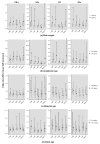Ambient Air Pollution and Sudden Infant Death Syndrome in Korea: A Time-Stratified Case-Crossover Study
- PMID: 31489898
- PMCID: PMC6765778
- DOI: 10.3390/ijerph16183273
Ambient Air Pollution and Sudden Infant Death Syndrome in Korea: A Time-Stratified Case-Crossover Study
Abstract
Sudden infant death syndrome (SIDS) is an occasional cause of unexpected mortality in infancy. While various etiological factors have been hypothesized, air pollution has been consistently presented as an environmental factor. In this study, we aimed to estimate the risk of SIDS in relation to exposure to air pollution and the effects of its modifying factors. A mortality dataset with supplementary infant mortality survey data from Statistics Korea was used and combined the concentration of ambient air pollution data from AirKorea based on the date of death and residential addresses of the SIDS cases. Odds ratios (ORs) were estimated according to birthweight, gestational age, maternal age, and infant age using a time-stratified case-crossover study design. The risk of exposure to particulate matter of less than 10 μm in diameter (PM10), nitrogen dioxide (NO2), carbon monoxide (CO), and sulfur dioxide was estimated. The number of deaths due to SIDS was 454 (253 males and 201 females). The OR per 27.8 µg/m3 increment of PM10 was 1.14 (95% confidence interval [CI]: 1.03-1.25) and that per 215.8 ppb of CO was 1.20 (95% CI: 1.03-1.40) in all infants. In females, an increase in NO2 and CO levels was associated with a higher risk of SIDS in low-birthweight and preterm infants. The OR per 15.7 ppb increment in NO2 was highest among preterm infants, with a value of 5.12 (95% CI: 1.27-20.63), and low-birthweight individuals, with a value of 4.11 (95% CI: 1.74-9.72), at a moving average of 0 to 3 days. In males, however, no significant association was found. In the present study, exposure to air pollution was associated with an increased risk of SIDS. This association was more evident in susceptible infants with a low-birthweight or in cases of preterm birth.
Keywords: air pollution; case-crossover study; epidemiology; risk factor; sudden infant death syndrome.
Conflict of interest statement
The authors declare no conflicts of interest.
Figures


References
Publication types
MeSH terms
Substances
LinkOut - more resources
Full Text Sources
Medical

